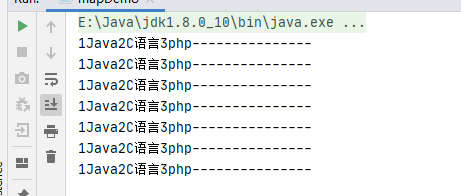HashMap的七种循环遍历方法
public class mapDemo {
public static void main(String[] args) {
// 创建并赋值HashMap
Map<Integer, String> map = new HashMap<>();
map.put(1, "Java");
map.put(2, "C语言");
map.put(3, "php");
// 遍历map
// 第一种方法 迭代器EntrySet
Iterator<Map.Entry<Integer, String>> iterator = map.entrySet().iterator();
while (iterator.hasNext()){
Map.Entry<Integer, String> next = iterator.next();
System.out.print(next.getKey());
System.out.print(next.getValue());
}
System.out.println("---------------");
// 第二种方法 迭代器 keySet
Iterator<Integer> iterator1 = map.keySet().iterator();
while (iterator1.hasNext()){
Integer next = iterator1.next();
System.out.print(next);
System.out.print(map.get(next));
}
System.out.println("---------------");
// 第三种 forEach EntrySet
for (Map.Entry<Integer, String> next: map.entrySet()) {
System.out.print(next.getKey());
System.out.print(next.getValue());
}
System.out.println("---------------");
// 第四种 forEach Keyset
for(Integer key : map.keySet()){
System.out.print(key);
System.out.print(map.get(key));
}
System.out.println("---------------");
// 第五种 lambda
map.forEach((key, value) ->{
System.out.print(key);
System.out.print(value);
});
System.out.println("---------------");
// 第六种 Streams Api 单线程
map.entrySet().stream().forEach((entry) ->{
System.out.print(entry.getKey());
System.out.print(entry.getValue());
});
System.out.println("---------------");
// 第七种 Streams API 多线程
map.entrySet().parallelStream().forEach((entry) ->{
System.out.print(entry.getKey());
System.out.print(entry.getValue());
});
System.out.println("---------------");
}
}
运行结果:























 435
435











 被折叠的 条评论
为什么被折叠?
被折叠的 条评论
为什么被折叠?










